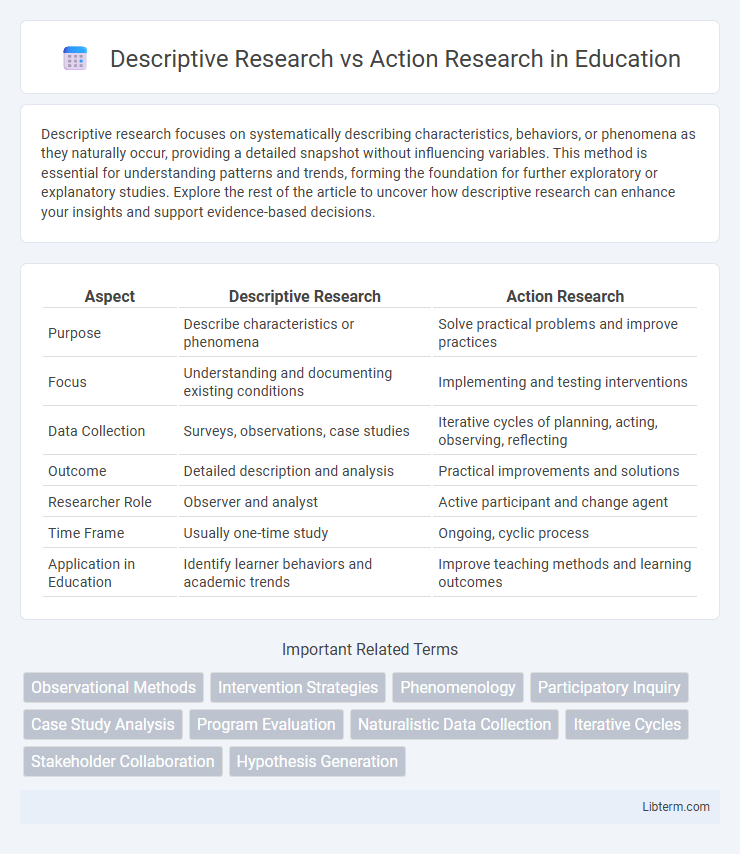Descriptive research focuses on systematically describing characteristics, behaviors, or phenomena as they naturally occur, providing a detailed snapshot without influencing variables. This method is essential for understanding patterns and trends, forming the foundation for further exploratory or explanatory studies. Explore the rest of the article to uncover how descriptive research can enhance your insights and support evidence-based decisions.
Table of Comparison
| Aspect | Descriptive Research | Action Research |
|---|---|---|
| Purpose | Describe characteristics or phenomena | Solve practical problems and improve practices |
| Focus | Understanding and documenting existing conditions | Implementing and testing interventions |
| Data Collection | Surveys, observations, case studies | Iterative cycles of planning, acting, observing, reflecting |
| Outcome | Detailed description and analysis | Practical improvements and solutions |
| Researcher Role | Observer and analyst | Active participant and change agent |
| Time Frame | Usually one-time study | Ongoing, cyclic process |
| Application in Education | Identify learner behaviors and academic trends | Improve teaching methods and learning outcomes |
Introduction to Descriptive and Action Research
Descriptive research systematically describes characteristics of a population or phenomenon, using methods like surveys, observations, and case studies to collect quantifiable data for identifying patterns and trends. Action research involves a cyclical process of planning, acting, observing, and reflecting, aimed at solving specific problems through active collaboration between researchers and participants, often within educational or organizational settings. Both methodologies emphasize data-driven insights, with descriptive research focusing on understanding 'what is' and action research targeting practical improvements through iterative inquiry.
Defining Descriptive Research
Descriptive research systematically depicts characteristics of a population or phenomenon, focusing on answering "what" questions through observation and data collection. It provides a detailed, accurate portrayal of variables without manipulating the study environment, making it essential for understanding current conditions or trends. This contrasts with action research, which aims to solve practical problems through iterative cycles of planning, acting, and reflecting.
Defining Action Research
Action research is a participatory and iterative research approach that aims to solve practical problems through cycles of planning, acting, observing, and reflecting. Unlike descriptive research, which focuses on systematically describing characteristics or phenomena, action research emphasizes collaborative problem-solving and change within real-world contexts. It actively involves stakeholders in the research process to generate actionable knowledge and improve practices.
Key Differences between Descriptive and Action Research
Descriptive research systematically observes and describes phenomena as they naturally occur, emphasizing accurate representation without influencing variables. Action research actively involves collaboration between researchers and participants to solve real-world problems through iterative cycles of planning, acting, and reflecting. Key differences include the purpose--descriptive research aims to describe, while action research aims to bring change--and the researcher's role, which is observational in descriptive research versus participatory in action research.
Objectives of Descriptive Research
Descriptive research aims to systematically describe characteristics, behaviors, or phenomena as they naturally occur, providing a detailed snapshot without manipulating variables. It focuses on identifying patterns, frequencies, and correlations within the data to establish an accurate portrayal of the subject. This research type prioritizes gathering comprehensive information to inform further analysis or development of hypotheses.
Objectives of Action Research
Action research aims to solve specific problems or improve practices through iterative cycles of planning, acting, observing, and reflecting. Unlike descriptive research, which primarily seeks to describe phenomena or gather detailed information, action research focuses on practical intervention and collaboration with stakeholders to achieve tangible change. The primary objectives of action research include enhancing effectiveness, fostering continuous learning, and promoting organizational or community development.
Research Methods and Approaches
Descriptive research employs systematic observation and data collection to describe characteristics or functions of a phenomenon without manipulating variables, emphasizing quantitative surveys, case studies, and observational methods. Action research integrates iterative problem-solving within a participatory approach, combining data collection and intervention to improve practices collaboratively, often utilizing qualitative methods such as interviews, focus groups, and reflective journals. Both research methods prioritize context-specific understanding, yet descriptive research aims for objective analysis while action research focuses on practical outcomes and stakeholder engagement.
Advantages and Limitations
Descriptive research provides a detailed and accurate portrayal of characteristics or phenomena, enabling researchers to gather comprehensive data on variables without manipulation, which is ideal for identifying trends and relationships. However, it limits the ability to establish causal relationships and may be susceptible to biases due to its observational nature. Conversely, action research promotes practical problem-solving through iterative cycles of planning, acting, observing, and reflecting, fostering collaboration and real-time improvements, but its context-specific results often lack generalizability and can be time-consuming.
Practical Applications in Various Fields
Descriptive research systematically gathers detailed information to characterize phenomena, supporting fields like healthcare for patient profiling and market research for consumer behavior analysis. Action research focuses on solving practical problems through iterative cycles of planning, acting, observing, and reflecting, widely used in education to improve teaching methods and in organizational development for process enhancements. The complementary use of descriptive research for understanding contexts and action research for implementing solutions drives innovation across social sciences, business, and community development projects.
Choosing the Right Research Approach
Selecting between descriptive research and action research depends on the study's objectives and desired outcomes. Descriptive research provides a detailed understanding of phenomena through observation and data collection without intervention, ideal for exploring existing conditions or trends. Action research emphasizes solving specific problems through iterative cycles of planning, acting, and reflecting, making it suitable for practical applications requiring immediate change or improvement.
Descriptive Research Infographic

 libterm.com
libterm.com